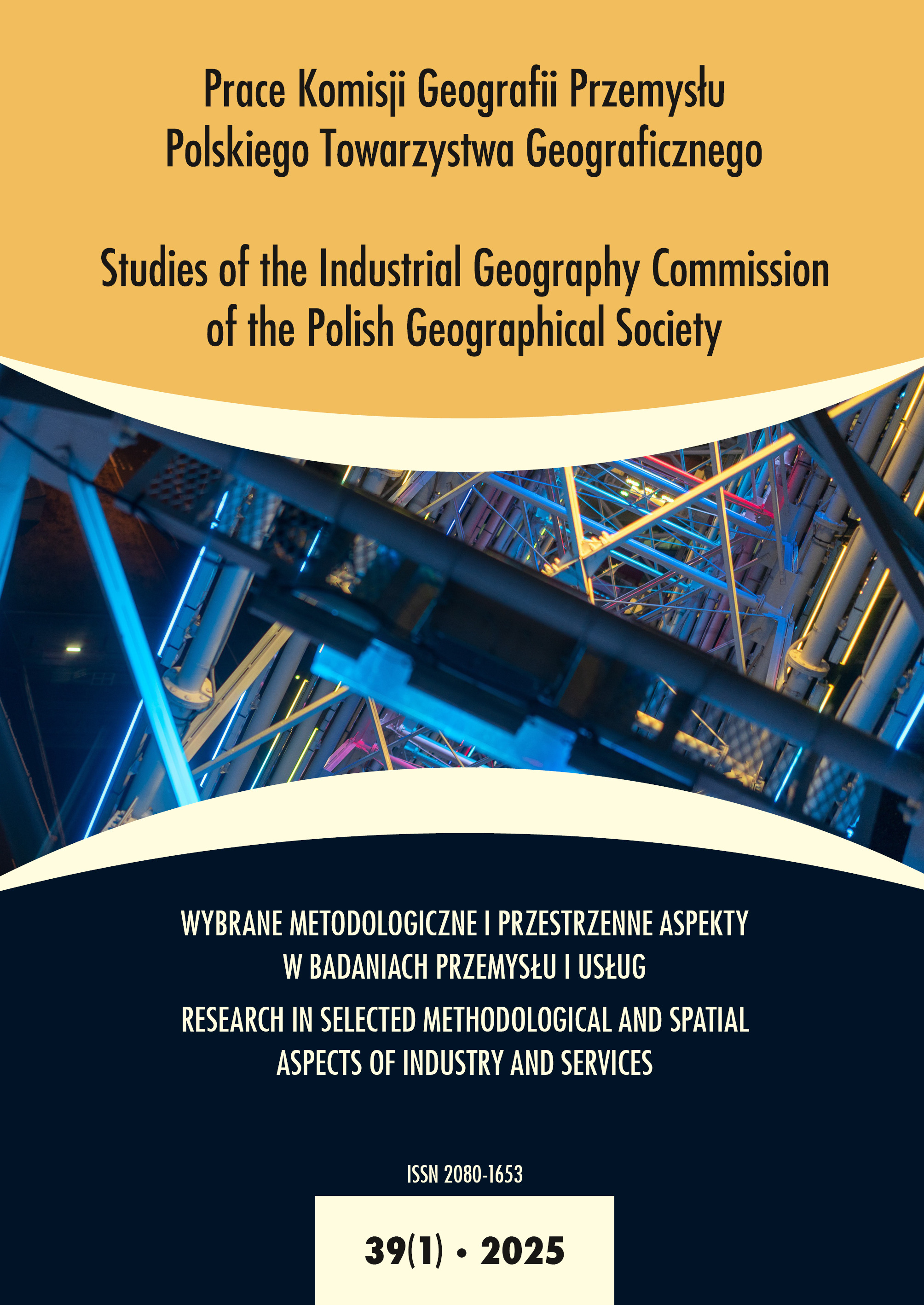Structural Transformation in EU Economies: a Possible Development Path for Ukraine
DOI:
https://doi.org/10.24917/20801653.391.5Keywords:
economy, structure, spatial transformation, regions, development, gross added value, labour productivityAbstract
The aim of the article is to assess the structural and spatial transformation of the economies of European countries (and primarily Poland) after their accession to the EU in terms of the value of their experience for Ukraine. To achieve this goal, the scientific basis of economic growth was investigated; an analysis of the spatial differentiation of the socio-economic development of individual EU countries was carried out; an assessment of the structure of the gross added value of the Polish economy and its regions in terms of types of economic activity; the localization coefficient of the economy of Polish voivodeships was calculat- ed; and the level of labour productivity in key economic sectors of Polish voivodeships was determined. The research results revealed patterns of structural and spatial transformation for individual EU countries under the influence of economic globalization and the strengthening of European integration. It was empirically proven that such transformations can be concentrated on agriculture and several low-tech and low-efficiency segments of industry along with the service sector. Methodological and organizational errors were identified in overcoming imbalances in socio-economic development. The results of the study substantiated conclusions for Ukraine on avoiding the risks of ineffective economic development, based on the experience of Poland and other EU countries.
Downloads
Metrics
References
Arti Grover Somik, V., Lall J.T. (2024). Agglomeration Economies in Developing Countries A Meta- Analysis. Retrieved from: https://www.centreforcities.org/reader/office-politics/the- impact-of-agglomeration-on-the-economy/ (access: 8.01.2025).
Bazhal I. (2017). Schumpeter’s innovations as the main factor of economic development. The role of the State in Economic Development. State Capacity, State Autonomy and Economic Development: proceedings to the 29th EAEPE Annual Conference, Budapest, Hungary, 19–21 October, Budapest. Retrieved from: https://ekmair.ukma.edu.ua/han- dle/123456789/13102 (access: 8.01.2025).
BRE. (2024). Boosting the regional economy. Retrieved from: https://www.bmwk.de/Redaktion/ EN/Dossier/regional-policy.html (access: 8.01.2025).
Capello R., Cerisola, S. (2023). Industrial transformations and regional inequalities in Europe.
Annals of Regional Science, 70, 15–28. doi: https://doi.org/10.1007/s00168-021-01097-4 Duernecker, G., Sanchez-Martinez, M. (2023). Structural change and productivity growth
in Europe – past, present and future. European Economic Review, 151. doi: https://doi. org/10.1016/j.euroecorev.2022.104329
Facility. (2024). Plan for Ukraine Facility (2024–2027). Retrieved from: https://www.ukrainefa- cility.me.gov.ua/ (access: 8.01.2025).
Freeman, C. (1982). The economics o f industrial innovation. Cambridge: The MIT Press.
GFCF. (2024). Gross fixed capital formation (% of GDP). Retrieved from: https://data.world- bank.org/indicator/NE.GDI.FTOT.ZS?end=2022&locations=PL- DE- UA&name_de- sc=true&start=1978&view=chart (access: 8.01.2025).
Gurgul, H., Lach, Ł.(2019). Regional patterns in technological progress of Poland: the role of EU structural funds. Central European Journal of Operations Research, 27, 1195–1220. doi: https://doi.org/10.1007/s10100-018-0556-5
Hacker, B. (2024). Unequal Europe Tackling Regional Disparities in the EU. Retrieved from: https://library.fes.de/pdf-files/bueros/stockholm/18349.pdf (access: 8.01.2025).
Heinisch, K., Holtemöller, O., Schult, C. (2021). Power generation and structural change: Quantifying economic effects of the coal phase-out in Germany. Energy Economics, 95. doi: https://doi.org/10.1016/j.eneco.2020.105008
Herrendorf, B., Rogerson, R., Valentinyi, A. (2014). Growth and structural transformation. Handbook of Economic Growth, 2, 855–941. doi: https://doi.org/10.1016/B978-0-444- 53540-5.00006–9
Imbs, J., Montenegro, C., Wacziarg, R. (2012). Economic integration and structural change. Political Economy Seminar, Toulouse. Retrieved from: https://www.tse-fr.eu/sites/default/files/me- dias/stories/sem_12_13/eco_politique/imbs.pdf (access: 8.01.2025).
Industrial Parks. (2024). Falling into the Same Trap Once Again? Retrieved from: https://vox- ukraine.org/longreads/industrial-park/article-en.html (access: 8.01.2025).
Kaldor, N. (1957). A model of economic growth. The Economic Journal, 67(268), 591–624. doi: https://doi.org/10.2307/2227704
Kotowicz-Jawor, J. (ed.). (2016) Innowacyjność polskiej gospodarki w przejściowej fazie rozwoju. Instytut Nauk Ekonomicznych Polskiej Akademii Nauk. Retrieved from: https://issuu.com/ inepan/docs/kotowicz-jawor_innowacyjno low (access: 8.01.2025).
Kotowicz-Jawor, J.(2015). Endogenne bariery przejścia polskiej gospodarki do innowacyjnej fazy rozwoju. Studia Ekonomiczne, 3(86), 394–302. Retrieved from: https://inepan.pl/images/ pliki/SE/SE_2015_3_02_kotowicz_jawor.pdf (access: 8.01.2025).
Lewis, W.A. (1954). Economic development with unlimited supplies of labour. The Manchester School of Economic and Social Studies, 22(2), 139–191. doi: https://doi. org/10.1111/j.1467–9957.1954.tb00021.x
Liana-Eugenia, M., Nicoleta-Georgeta, B. (2013). The Role of Industrial Parks in Economic Development. Annals of Faculty of Economics, 1(1), 123–130. Retrieved from: https://ideas. repec.org/a/ora/journl/v1y2013i1p123-130.html (access: 8.01.2025).
MDS. (2024). Main Directorate of Statistics of Poland. Retrieved from: https://stat.gov.pl/ (access: 8.01.2025).
Nayyar, D. (2019). Structural change and economic transformation. Resurgent Asia: Diversity in Development. Oxford: Oxford University Press. doi: https://doi. org/10.1093/oso/ 9780198849513.003, 4
RDPG. (2024). Regional Development Policy in Germany. Retrieved from: https://www.oecd.org/ cfe/_Germany.pdf (access: 8.01.2025).
Resbeut, M., Gugler, P. (2016). Impact of clusters on regional economic performance: A methodo- logical investigation and application in the case of the precision goods sector in Switzerland. Competitiveness Review, 26(2), 188–209. Retrieved from: https://www.emerald.com/in- sight/content/doi/10.1108/CR-09-2015-0078/full/html (access: 8.01.2025).
Schlogl, L., Sumner, A., Schlogl, L., Sumner, A. (2020). Disrupted Development and the Future of Inequality in the Age of Automation. Cham: Palgrave Macmillan, 11–20. doi: https://doi. org/10.1007/978-3-030-30131-6_2
Stöllinger, R. (2016). Structural change and global value chains in the EU. Empirica, 43, 801–829. doi: https://doi.org/10.1007/s10663-016-9349-z
Ishchuk, S.O. (2024). Transformation of Ukraine’s economy during war: key trends. Economic Herald of State Higher Educational Institution “Ukrainian State University of Chemical Technology,” 2(20), 29–40. Retrieved from: http://ek-visnik.dp.ua/wp-content/uploads/
pdf/2024–2/Ishchuk.pdf (access: 8.01.2025).
Wisła, R., Nowosad, A. (eds.). (2020). Economic Transformation in Poland and Ukraine: National and Regional Perspectives. New York: Routledge. doi: https://doi.org/10.4324/9781003041375
Downloads
Published
How to Cite
Issue
Section
License
Copyright (c) 2025 Studies of the Industrial Geography Commission of the Polish Geographical Society

This work is licensed under a Creative Commons Attribution-NoDerivatives 4.0 International License.
Articles are published under the terms of the Creative Commons License (CC BY-ND 4.0; Attribution– NoDerivs).

